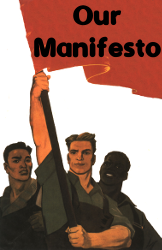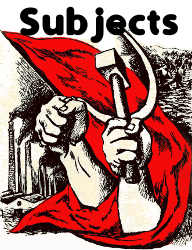




|
Remembering
the History of the Cotton Workers Struggle
Il Grido del Popolo
(The Cry of the People)
9 December 1916 Mazzonis, Poma, Hofmann, Leumann, Wild, etc. These names are brought to our attention once again. Ten years have passed. The workers' organizations have grown stronger, and class consciousness has transformed the proletariat. The workers are no longer helpless particles of dust in the chaos of capitalist society. They are soldiers fighting for an idea, a crusade advancing to the conquest of a promised land. They know what they want, they have tightened their ranks, they have forcibly demanded recognition of their value. Now they are currently moving on to the assault, well-disciplined, well-equipped, determined to overcome any resistance, determined to impose their will. In place of their pain and suffering they now have a lucid awareness of their rights, and their humility and resignation of just a short time ago has become a will to fight. The cotton-workers' strike is both a demonstration and confirmation of this fact. Ten years of work have produced these results. True, the names Mazzonis, Poma, Hofmann, Leumann, Wild are being brought once more to our attention, but how changed in their significance - even the bosses' consciousness has been transformed. The mediaeval castle has been largely pulled down by the assiduous blows of the workers' organization, the moat has been filled in, the feudal lord's throne has been left to rot on the garbage dump, and now it is two forces which stand facing one another: capital and labour. But now labour has just as much nobility as capital or even more so, it is no longer humiliated before it. Now labour is capital's equal and there is nothing servile in its gaze, for now it has the strength to outstare the vultures that gnaw at its vitals, that feed off its crimson blood, off its vital energy. 1906 was the year when the cotton workers' revolt began. On this occasion too it was blood that cemented the new edifice that was being built. The general strike was the concrete testimony that every section of the workforce was dependent on the solidarity of the whole of the working class for its victory. Let us recall the facts. Let us use these facts to strengthen our consciousness, let us immerse our spirit in the river of our own traditions, of our own history. In 1906 the workers' organization was still at a critical stage in its development: it was not recognized by the bosses. These latter were seeking to kill it while it was still in the throes of birth, by refusing to grant it any status. They wanted to preserve intact the heritage of their privileges. They were aware of its fragile foundations; they were aware that the least fragment of masonry that became detached and fell into the abyss of oblivion would be followed by others, until the whole façade would come tumbling down. Hence they were tenacious in their resistance. In the first week of January 1906 a strike broke out in the weaving section of the Hofmann plant. A workers' committee led by Comrade Francesco Barberis presented itself to the directors. They refused to receive Barberis. They insisted the workers should return to their posts. What is more the directors reserved to themselves the right to readmit workers or not as they thought fit. The strike was strangled. When a woman worker in the Druent cotton-mill asked for a reference (she was the wife of Comrade Pietro Vietti), the director replied: “You deserve the reference, but I won't give it to you; and if your socialist husband were to come here, and even if the police were to come, I would still refuse just the same. You don't have the deference to the owner that a worker ought to have if she is to deserve a reference.” Early in March the women who operated the spinning machines in the Poma cotton-mill were told that from then on everyone would have to work 50 machines. The workers made their just remonstrances. Poma set an example by sacking all women who refused to work more than 25 machines. Meanwhile the workers were trying to strengthen their organization so as to be able to reply with dignity to the bosses' provocations. Propaganda work, through newspapers and rallies, was stepped up. On 28 March the secretary of the Turin district office of the National Confederation of Textile Workers, Luigi Mainardi, gave a talk on the specific theme: “The textile industry must be organized.” The bosses reacted immediately. Over the first two weeks of April the textile industrialists of Turin and the surrounding district – Wild, Mazzonis, Leumann, Hofmann – sacked and booted out any worker who had been a member of the strike committees. The textile industry had been expanding at a tremendous rate: new factories mushroomed, while the existing ones doubled and tripled their output. And in the course of this flourishing growth the capitalists protected their interests behind thick barbed-wire entanglements. The living conditions of the wage-workers became truly hellish: their wages, their treatment, the shameful hours they worked, the directors and foremen like gaolers and their henchmen – every tiny lapse was punished by a fine. And woe to anyone who complained, who dared even grumble under her breath – she was sacked on the spot. The firm Mazzonis earned itself a reputation amongst the working women as the most tyrannical in its behaviour, the most savage in its reprisals. A strike by the wage-workers in 1904 had brought to light the exorbitant and infamous exploitation the women were subjected to in its workshops. The statistics published at the time make one shiver. Wages were rarely more than 1.20 a day, and even this wretched sum was continually clawed back by fines, withholdings, and arbitrary dismissals. The statistical yearbook of the Ministry of Health provided the following figures for each thousand deaths as a result of pulmonary consumption. Year Middle-class women Milliners/Seamstresses Spinsters/Weavers 1899 52.27 390.95 342.07 1900 47.62 246.45 410.26 1901 35.09 266.36 250.72 1902 52.17 304.76 357.1 1903 50.91 253.97 484.85 In other words, in 1903, for every 1,000 women who died from pulmonary consumption, 484, or nearly half, were textile workers. The capitalist development of the textile industry had required a terrible holocaust of proletarian lives. The firm Poma vied with Mazzonis. The “fabricôn” had become synonymous with penal servitude. In a socialist song in the local dialect, the "fabricôn" recurs again and again in the chorus; (1) it has been painfully hammered into the memory of the Turin proletariat. Around 15 April the firm of Mazzonis sacked without any plausible reason 25 comrades, precisely the women whose activities had been most prominent, giving them 8 days' notice. The textile workers' union sent a communiqué to the socialist press that was both a cry of pain and an energetic protest. Agitation was stepped up. Besides, in that year 1906 the whole of the Turin proletariat was on the boil: there was an flammable atmosphere as a result of a whole series of agitations. There had been the metal-workers' strike; there had been the administrative elections which the socialist minority won by 11,000 votes, preceded by furious polemics with the newspapers representing the bourgeoisie; there had been the trial of the anti-militarists; there had been the great funeral procession in honour of the victims of the Courrieres mine disaster in France. As a result of these episodes, with feelings inflamed by such a succession of class actions, the consciousness of each worker had been welded into a unified whole, and the sense of solidarity was acute. On 22 April a great meeting was held in the offices of the Borgo Vittori branch of the Socialist Party to discuss the victims of the sacking and how to organize. The representative from the textile workers' union declared that the meeting was called “to achieve an effective and solid organization of the 10,000 women textile workers that would enable them to stand up to the likely future battles against the grasping exorbitance of the all-powerful textile bosses.” In the first few days of May the agitation became threatening. In all the textile workshops the women, even those who were unorganized, were united in their demand for more humane treatment. Their principal demand was for a reduction in working hours from 11 to 10, without loss of wages. The industrialists prevaricated, and the authorities failed to cow them after successive interventions. The strike began: one by one the workshops emptied and production came to a halt. The masses thronged into the offices of the Chamber of Labour. A general textile strike was declared and immediately it began to spread: it was in fact a spontaneous outburst on the part of the women workers, most of whom were unorganized, that could not be contained. A manifesto issued by the Chamber finished with these words: “May these women workers bring to their struggle the tenacity and faith of people who know that they have right on their side, may they bring to it their utmost spiritual fervour, the throbbing of a mother's or a wife's heart, determined to have done once and for all with this killing work. Behind them the whole of the Turin proletariat stands alert, ready to rush to their aid.” On Sunday 6 May the strikers marched in a long procession up the Cavoretto hill from Corso Siccardi. Allasia, Castellano and Barberis spoke to the meeting. On Monday the strike spread to plants in other industries, particularly engineering shops. Demonstrators' banners crossed the city on their way to Corso Siccardi, and there the first incidents with the forces of law and order, who intervened to a considerable extent, occurred. The cavalry charged, trying to disperse the crowd that had gathered in the offices and in the streets around the Casa del Popolo in Corso Siccardi. The usual things happened. Around 6:30 in the evening when the men and women were fleeing once again before the cavalry, there was a terrible crush just inside the main gateway. (2) A few stones began to fly. Policemen in plain clothes moved forward. One of them rushed forward with levelled revolver. The first shots were fired, and then the air was thick with them. The crowd sought refuge inside the building. Eight people were wounded. The most serious case was Giovanni Cravero, who had part of his skull blown off, his brains mangled and a terrible haemorrhage. The other seven were in better condition, suffering bullet wounds, sabre and dagger wounds. The front door was riddled with bullet holes. The Chamber of Labour was invaded, and 22 people arrested. Then the building was occupied by the army. In the evening representatives from the Central Office of the Chamber of Labour and many comrades from the political organization met in the Dora district office of the party and voted in favour of declaring a general strike, and at once proceeded to draw up a manifesto. On Tuesday, the day after, the strike was 100 per cent solid. In this way the struggle for the 10 hour day had its baptism of blood. On the Monday after these tragic events the industrialists assembled together and voted in favour of this resolution: “In the light of the popular disturbances and for the sake of peace, the cotton industrialists hereby concede the 10 hour day. Plants will re-open from tomorrow, Tuesday, morning.” But there was a general strike, and the textile workers did not return to work. Negotiations dragged on for the whole of Tuesday, until the industrialists had clarified their concessions in concrete terms. And it was only very late in the evening, at 11:30, that the industrialists released a declaration to the union, signed by Poma, Mazzonis, Wild, Abegg, and Bass, confirming the reduction of the working day to 10 hours, with the assurance that this would not incur any loss of wages. On Wednesday at mid-day the general strike came to an end. In the morning an enormous procession 40,000 strong had marched through the streets, dispersing in Piazza Vittorio. In this way the women workers succeeded in winning one of their rights. But the blood dried on the stones of the entrance hall to the Casa del Popolo. And those miserable speculators, those jackals of industrialists, were no longer afraid of its acrid smell. So they tried to exact revenge. The industrialist Poma lost no time in making himself an agent provocateur. He offered a novel interpretation of the declaration of 8 May in which it was guaranteed that there should be no reduction in textile workers' wages. No reduction, according to Poma, referred to the hourly, not the daily rate. In this way he sought to wrest back from the workers a part of their gains: he was trying to reduce their already meagre wages by a tenth. Poma's arrogance was unique. His cavilling, his arguments stand today as testimony to his shameless lack of moral rectitude. But his work-force had changed; the experience of the strike, at first a sectional one but culminating in a general stoppage, had produced its effects, and had consolidated a feeling of class solidarity. So his 200 workers stopped work again, and stayed out until they had won a decisive victory. The other industrialists had to keep in line to avoid getting troubles of their own. The strike was solid for 56 days, despite the intervention of the priests who organized scabbing and used their slimy propaganda to try to swing public opinion behind the poor industrialists. But the strikers were able to count on the total solidarity of their comrades: 40,000 Lire were distributed in subsidies, and the spectre of a general strike loomed up again. On 18 July the Right Hon. Anselmo Poma's wage-earners started work again after two months out, having had all their demands met in full. (3) As a result of these struggles, which are rapidly summarized here through pressure of time, the textile workers created their solid class organization. Now they are confronting their bosses once again. And we are sure that once again it will be the bosses who bite the dust. (1) This is the chorus referred to: “En t'iufficine, n't'iufficine ai manca l'aria, – an t'le suffiete, n't le suffiete ai mance l'pan! – Custa l'è la vita prulataria – che l'uvriè, a fa tut l'an.” (“In the workshops, in the workshops, there is no air, – in the garrets, in the garrets, there is no bread, – This is the proletarian life that the worker, the worker, leads the whole year through.”) (2) The portone of the typical Italian palazzo is a huge wooden door opening onto a paved hallway leading to a courtyard. Access to the building is from this courtyard, not directly from the street. (3) The title onorevole means that Poma was a parliamentary deputy. |